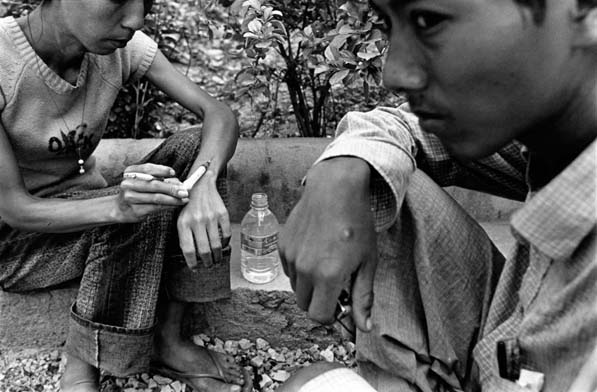Withdrawal Symptoms

“I use ya ma because life here is hard,” said a 25-year-old Burmese sex worker in Ruili, who said she sometimes takes up to 20 tablets a day. “In the morning I take five pills. If I do sex work, I will take some more, because sex work is very tough. After taking the pills I feel fresh, and I am very patient with my clients.”
While some drug users have made a shift from opiates to ATS, many heroin users seek pharmaceutical alternatives that have similar narcotic—rather than stimulant—effects.
Addicts and users have a wide variety of strategies for coping with the scarcity or unaffordable prices of heroin, including cocktails of pharmaceutical drugs in the form of pills, cough syrups and injection ampoules.
Others cope by taking large amounts of detoxification pills or experiment with drugs used in hospitals to anesthetize patients, incurring a high risk of overdose. Some take pills with a low dosage of opiate inside that are normally used to treat diarrhea or other illnesses. “They take 40 pills at once. You can get them at the pharmacy,” said another user.
Apart from the obvious health and social problems that drug addiction causes, the repressive legislation that criminalizes drug use hampers addicts’ access to health services. Drug laws across the region are excessively harsh and penalties are disproportionately high relative to the offense. In government-controlled areas in Burma, possession of just a handful of pharmaceutical tablets—without a medical prescription—can result in up to five years imprisonment. Anyone arrested with more than 0.2 grams of heroin can be sentenced to 15 years and being caught with more than five ya ma pills or five grams of cannabis can lead to 20 years in jail.
In areas controlled by ethnic ceasefire groups in Kachin or Shan states, those arrested for drug use or for possession of small amounts of drugs for personal consumption are usually imprisoned and then released after suffering “cold turkey” in custody for a few months.
“We put many drug users in jail,” says an official of the Kokang ceasefire group. “We give them a three-month sentence the first time they are arrested. If they are caught again, they get 6 or 12 months. We make them work in the daytime and keep them in prison at night. The work includes building roads and working on rubber and sugarcane plantations. It is hard work.”
An official from the New Democratic Army-Kachin (NDA-K) ceasefire group said that they had recently arrested about 40 drugs users and dealers in Pangwah.
“The dealers are also poor,” he said. “They sell ya ma and heroin just for their daily needs. After arresting those users and sellers, we noticed that their families got into difficulties, too.”
According to the NDA-K official, opium is still the most common drug in the villages, while in the towns most users take heroin and ya ma. “We need programs and medicines for drug users. But our region is very backward. The central government does not provide anything for us,” he said.
The human tragedy is most visible in the Burmese-Chinese border areas. There are many problem drugs users in every town and poverty, social exclusion and diseases are widespread.
What is urgently needed in Burma is an upscaling of quality treatment and harm reduction programs and a revision of drug laws with a view to treat drug users no longer as criminals but as human beings with a right to health care. The issues of human rights in drug control and proportionality of sentences should be high on the policy agenda.
Martin Jelsma is the coordinator of the Drugs and Democracy Program of the Transnational Institute (TNI) based in Amsterdam.
TNI’s study “Withdrawal Symptoms—Changes in the Southeast Asian drugs market” is available at www.tni.org/drugs. A team of fifteen researchers is involved in an ongoing TNI research effort in the region and a more detailed report will be presented at the end of this year.
« previous 1 | 2 |
